Menus
- The basis of driving pleasure
- engine and gears
- landing gear
- Brakes
- Equipment and handling
- MOTORCYCLE conclusion
- Download PDF
- Used Ducati Supersport in price comparison

Arturo Rivas
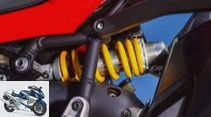
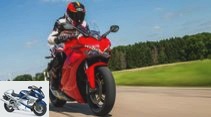
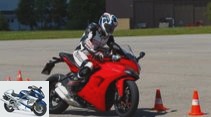
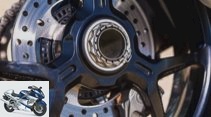
17th photos
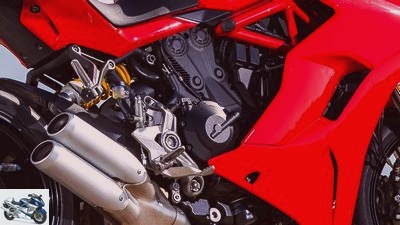
Rivas
1/17
Engine: The chocolate side of the Supersport is its extremely powerful two-cylinder. It has the punch in the right place, exactly where you need it for fun and relaxed cornering on the country road: between 3000 and 6000 rpm. He is also well-mannered with load changes and responsiveness. This only applies to a limited extent to the clutch and the gearbox, which, correctly adjusted, may not shift smoothly, but shifts properly.

Rivas
2/17
Chassis: The Ducati chassis collects strong points in all criteria relevant to driving dynamics. Stable, trustworthy and with a healthy dose of handiness and precision, it is suitable for sporty country road riding. In terms of suspension comfort, the suspension elements, especially the shock absorber, still have some room for improvement. Otherwise, however, the chassis shows practically no nakedness.
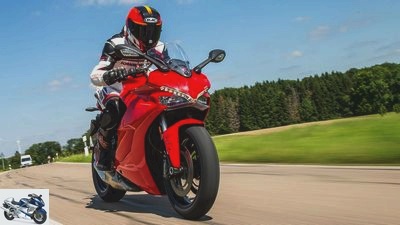
Rivas
3/17
Everyday life: The driver is comfortably positioned, not completely averse to a pillion passenger, the SuperSport also proves everyday competence with all sporty talents. The adjustable pane provides wholesome wind protection. Only the vibrating mirrors and the large turning circle are a bit out of the ordinary. Without optional panniers, the possibilities for storing luggage are quite limited, but the payload and range are worthy of a sport tour.

Bilski
4/17
Costs: Thanks to the 15,000 intervals for the inspections and a consumption of well under 5 liters per 100 kilometers, the Supersport is not too difficult for its owner.

Rivas
5/17
Safety: The brakes are another highlight on the Supersport. Experienced hard brakes can even put down extremely short braking distances in ABS mode. For everyone else, mode two still allows excellent braking values. The erection moment is low.

Rivas
6/17
Overall evaluation and price-performance rating: Even in the basic version, the Supersport is not a cheap one, but thanks to the respectable number of points there is still a straight two-point zero.

Rivas
7/17
Can be expensive in the event of a fall: the non-slip catches sit on a cast part to accommodate the swing arm.
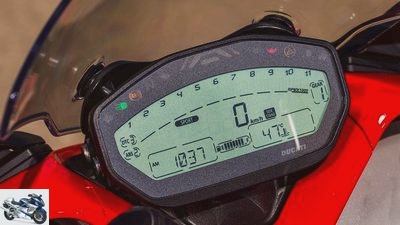
Rivas
8/17
Well-known, clear cockpit, on which a lot of information has to share a display field
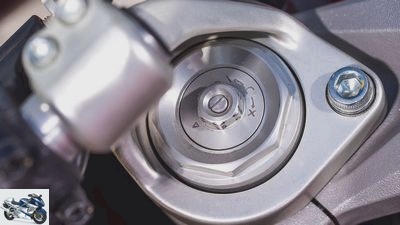
Rivas
9/17
Fully adjustable fork, the handlebars partially cover the adjusters for the preload.

Rivas
10/17
Also an eye-catcher at the base: comfortable bench with neat decorative stitching.
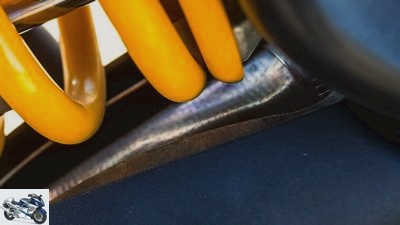
Rivas
11/17
Heated proximity: the manifold was indented to make room for the shock absorber.
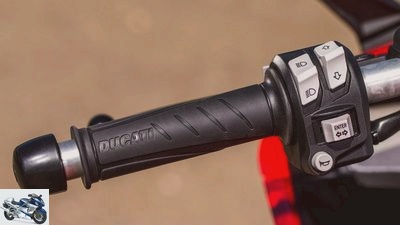
Rivas
12/17
Only one button for the display operation, scrolling in the menu is only possible in one direction.

Rivas
13/17
The basic Supersport has the same high-quality brake components as the Ducati Supersport S..

Rivas
14/17
… Adjust the height by 40 mm with one hand while driving.
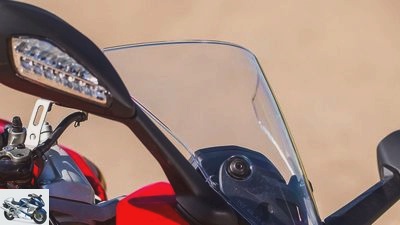
Rivas
15/17
If you need a little more wind protection, the window can be …

Bilski
16/17
The on-board tool kit does contain a fastening rope for the helmet and a gripper for the safety catches, but there is no hook wrench for adjusting the preload on the shock absorber.
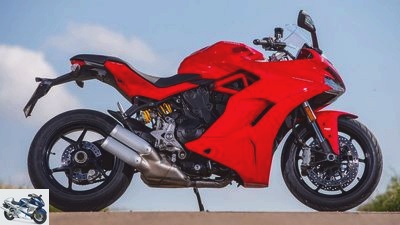
Rivas
17/17
Tight rear, front wheel-oriented design, cool stub exhaust. The SuperSport appeals with its clear lines.
Ducati Supersport in the top test
The basis of driving pleasure
Basic models with more expensive S, R, RS or RR variants than sister models are heavily fashionable. The Ducati Supersport S has already collected a lot of merits. But what does the basic version, which is 1,600 euros cheaper, do?
The D.ucati Supersport S was voted the most beautiful motorcycle at the fair at EICMA 2016 in Milan. Wherever she appears, sympathies fly to her and she has done excellently in tests so far. On the other hand, at least 14,600 euros for a 110 hp motorcycle is a hearty announcement.
Buy complete article
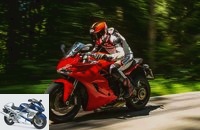
Ducati Supersport in the top test
The basis of driving pleasure
Sitting position
The Ducati Supersport shares the technical basis with the S version: the same 110 hp 937 cm³ V2 is in the same tubular frame, which is equipped with the same single-sided swing arm. There is a tie between the bikes and the seating arrangement: comfortable upholstery and a sporty, but not too narrow knee angle. The handlebar stubs are very accommodating to the driver thanks to the high extension arm and an upright, relaxed seating position.
Here we go! The Ducati Supersport starts work spontaneously. Oops, when it is cold the clutch tends to engage very sharply, which takes away some of the elegance from the first start. That seems to be a peculiarity of the 937 engine, as our long-term test Multistrada 950 and the Supersport S show. If the lamellas and oil are warmed up, the smooth slipper clutch can be dosed properly.
engine and gears
With the 937 Twin, Ducati has hung a wonderful drive for country road racing between the wheels. Even in the hustle and bustle of the city, the V2 is well mannered in the lower gears thanks to sufficient flywheel mass and good running smoothness below 3000 rpm.
Its true entertainment value, however, opens up to the pilot during a brisk ride over winding streets. Wacker pulls the Ducati Supersport out of the speed range. Its engine characteristics are made for relaxed, brisk highway robbers: At 4000 rpm it really grabs, toil confidently through the mid-rev range, which is blessed with a proper torque curve.
It cheerfully turns upwards and pushes out of curves so forcefully that even drivers of more powerful machines have to stretch to keep up. Without hectic turning horror, the Ducati Supersport offers plenty of propulsion for robust intermediate sprints.
The transmission, however, is not one of the most polished representatives of its kind. Especially at low speed, the gears rest hard, sometimes it rubs and hooks from the second to the first. But this is also already known from other models with this drive.
The V2 hangs cleanly on the gas and does not annoy you when you apply the gas with too harsh performance. It sounds self-confidently from its double barrel, and in push mode it crackles and sizzles to your heart’s content at 2500 rpm. When it has to go quickly, it can be squeezed out to the limiter. Even at 130 km / h in last gear, the Ducati Supersport accelerates vigorously.
Thanks to the proper wind protection, the driver does not have to fold behind the fairing even at 200 km / h. For a little more comfort, the pane can be raised by hand to a position around 40 millimeters higher. So the Ducati Supersport cuts a fine figure even on fast stretches of the motorway. Only at 253 km / h (according to the speedometer) does the limiter intercept it gently.
landing gear
Rivas
Ducati Supersport shock absorber
The Ducati Supersport is also tailor-made for relaxed cornering when it comes to the chassis. Their handling does not have the aggressive sharpness of thoroughbred sports files, but works precisely, reliably and predictably. She hits the desired line in a serene manner, free of nervousness, that makes you quick in a relaxed way. Although it is “only” equipped with a Marzocchi fork and a Sachs shock absorber, the Ducati Supersport does not suffer from ailments during parforcer ride even on a second-class surface. It parries lane ridges in fast motorway bends just as confidently as undulating country road asphalt.
The set-up tends to be on the comfortable side, especially on the fork. So the Duc does not stumble even at brisk pace and rapid lean changes, shines with great stability in lean positions and therefore does not have to hide behind the S version with Ohlins chassis in terms of driving dynamics. To do this, however, we have increased the spring preload at the rear a bit and opened the tight rebound stage significantly. Ducati deserves praise for indulging in the basic Supersport with the Pirelli Diablo Rosso III.
What can be seen on the country road is underpinned by the top test course: the times that Ducati Supersport and Ducati Supersport S achieve in fast and slow slalom are within a few tenths of a second. The S only achieves slight advantages in the circular path when crossing an edge. The Ohlins dampers act a little more confidently thanks to their better response and give the motorcycle even better contact with the road in deep lean angles.
The spring elements of the basic Supersport have a higher breakaway torque and do not scan the road surface as sensitively. You don’t work rough, but just a bit less smooth on small bumps. The differences are especially noticeable with stronger strokes, but there are no worlds that separate the two.
Brakes
Rivas
Ducati Supersport brake pump
The Ducati Supersport decelerates perfectly with a radial brake pump and monoblock calipers from Brembo, as long as you have selected the correct of the three modes for the deactivatable ABS. In defensive mode 3, the Duc remains extremely stable, but with 8.5 m / s² it is also well below its potential. She then needs 45.3 meters for an emergency stop from 100 km / h. The recommended mode 2 brings the Duc to a standstill safely and at 9.0 m / s² almost 2.5 meters earlier.
The sharp mode 1 deactivates the ABS on the rear wheel, so it is the tip for the racetrack. Because it grabs a lot at the beginning of the braking and allows strong stoppies towards the end in extreme cases. The driver’s sensitivity is required to achieve maximum deceleration. The excellent controllability of the stoppers helps not only in the border area. With up to 9.7 m / s² the Ducati Supersport decelerates robustly in mode 1 and is another 3 meters earlier than in mode 2.
Equipment and handling
Rivas
Ducati Supersport cockpit
The turning brings back memories of the Ducati Supersport from the 1990s: the steering angle is small, the turning circle is quite large at 8.6 meters, which sometimes requires several shunting trains on narrow streets. If you don’t grip the handlebars as far inside as possible, the space between your thumb and tank will also be tight.
The display of the Ducati Supersport has all the important information ready, but for example time, daily and total kilometers are stored in the same display field, but only one of this information can be displayed. To change, you can only zap through the menu in one direction, which is at least as impractical as changing the riding modes or the settings of the eight-level traction control and ABS.
When it comes to electronics, the Ducati Supersport is state-of-the-art, especially as there are three freely configurable driving modes on board. In addition, the driver has the choice between three performance levels: Sport and Touring release full performance with different responses, the rather dispensable Rain mode limits the performance to 75 HP and offers a very defensive response. Tester’s favorite was the straightforward sport mode.
The Ducati Supersport also scores with a large tank opening and moderate consumption of 4.7 l / 100 km at the pump. You shouldn’t fill up the Ducati Supersport to the brim if you want to turn it off afterwards with a hot engine, otherwise some of the expanding fuel will quickly run out of the overflow.
Better to go back on the road right away, because the Ducati Supersport is also good for that – not only because of the optional luggage case. Thanks to the successful ergonomics, you can easily last longer than a full tank of fuel in the saddle. The pillion seat is more than an emergency roll, which may not be suitable for the long journey, but is suitable for a longer stage. 193 kg payload leaves room for holiday luggage.
The Ducati Supersport manages to combine sporty qualities and suitability for everyday use, to be attractively packaged and – in the case of the basic version – to be offered at a reasonably affordable price.
MOTORCYCLE conclusion
Basic model equals lean food? Not in the case of the Ducati Supersport. The engine, brakes, wheels and tires, the electronics, it shares all of this with the more elegant S version. It offers slightly finer suspension comfort. But there are no worlds between the two. The basic Supersport is stingy on price, but not on driving pleasure.
Download PDF
The MOTORRAD measured values such as acceleration, torque, braking distance and consumption as well as the power and torque curve, the 1000-point rating and a competition overview: If you want to know exactly, you can find all the information for 2 euros in the original article.
Used Ducati Supersport in price comparison
1000PS marketplace app
You can save significantly on used Ducati Supersport.
If you don’t want to pay the full fee for a new Ducati Supersport, you are well advised to take a look at the used market. There you can find beautiful specimens with low mileage for significantly less money. You can see how much you can save with a used Ducati here: used Ducati Supersport in Germany.
Related articles
-
Ducati Monster 821 in the top test
Jahn 30th photos Jahn 1/30 Even when idling, the Duc shoots so heartily that you involuntarily want to check whether you have forgotten the silencer…
-
Ducati Hypermotard – the two-cylinder supermoto put to the test
Manufacturer 46 photos Ducati 1/46 Ducati Hypermotard 2013 in the driving report. Ducati 2/46 Red, a bit simpler, but quite functional: the Hypermotard…
-
Ducati SuperSport in the driving report
Ducati 24 photos Ducati 1/24 The entry into the sporty Ducati world is now again taken over by SuperSport. For the first trial ride, Peter was enough to…
-
Ducati Monster 1200 S in the top test
www. 33 photos 1/33 2/33 Noticeable negatively: When folding up, the tank gets stuck at the front, so the hinge at…
-
Comparison test BMW K 1200 RS against Ducati 944 ST2 against Honda VFR
Comparison test BMW K 1200 RS against Ducati 944 ST2 against Honda VFR Three just in case Three motorcycles, three different concepts, one requirement:…
-
Ducati 916 Strada Biposto in the test
fact 22nd photos fact 1/22 When the Ducati 916 came onto the market in 1994, the top test had not yet been carried out, hence the daring idea of…
-
Test Ducati M 750 Monster In the middle Ducati is striving towards monstrous times: Flanked by the 600 and 900 Monster, the M 750 is now paving a way….
-
fact 8th photos Ducati 1/8 Ducati 2/8 Ducati 3/8 Ducati 4/8 Ducati 5/8 Ducati 6/8 Ducati 7/8 Ducati 8/8 Top test Ducati Monster 696 Monster Inc You have…
-
Comparative test Ducati Multistrada 1200 S Touring old-new
Jahn 11 photos Jahn 1/11 Ducati Multistrada 1200 S old (model 2012 – white) versus new (model 2013 – red). Jahn 2/11 …Adjusts the electronics via…
-
Comparison test between Ducati Monster Dark and Suzuki SV 650
Comparison test between Ducati Monster Dark and Suzuki SV 650 Monster Dark and Doris Day Hardly on the market, the SV 650 turns into an everyday darling…